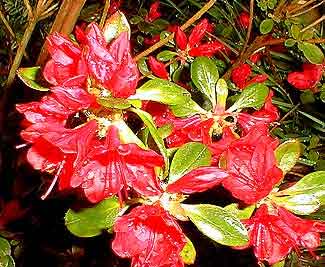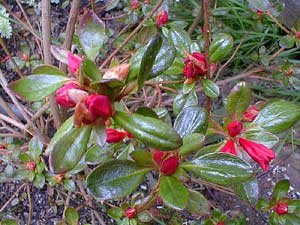
Stewartstown Azalea
"Azaleas, who give themselves to the wind."
-Florence Taber Holt,
1920
1920
An under-appreciated classic, the name 'Stewartsonian' is after Stewartstown, Pennsylvania, where Joseph Gables lived when, as a semi-professional nurseryman & professional farmer, he devoted his life to developing wonderful azalea hybrids that remain standards of beauty & hardiness.
Unfortunately Joe Gable never recorded the specific heritage of this marvelous hybrid, but R. poukhanense & Kaempferi azaleas provided the backbones of his breeding program.
It is a dwarf or semi-dwarf azalea. Very old specimens have been known to reach six feet tall. As a rule it has an upright habit, but we obtained one that was atypical. It was rather sprawling rather than upright. It was a twiggy thing, about two feet tall, & three feet wide. It is common for this hybrid to gain width faster than it achieves height, but not so common for its limbs to be horizontal to the ground. It was frankly poorly trained but at the time there were no other choices, & we wanted this variety specifically for its remarkable leaf color in autumn, figuring it would eventually improve its limb structure.
 Unfortunately during a summer heatwave in 2003, 'Stewartstonian' died. I had tried to keep it watered during the tough months, but it had not been a fully year in the ground & was not well-established, plus it was on a cliff-edge that I now realize simply has too sharp a drainage for shrubs that need to be kept moisture.
Unfortunately during a summer heatwave in 2003, 'Stewartstonian' died. I had tried to keep it watered during the tough months, but it had not been a fully year in the ground & was not well-established, plus it was on a cliff-edge that I now realize simply has too sharp a drainage for shrubs that need to be kept moisture.We did replace the shrub with another 'Stewartstonian' & this time we had choices of better shaped specimens that stood very upright & had thicker less twiggy stems. This one was installed in an area easier to keep moist, so if global warming continues to make our summers hazardous for cool-weather plants, 'Stewartstonian' will still be all right. The photos on this page, however, are of the original specimen before the summer heatwave did it in; eventually I'll be able to add photos of the new one.
The flowers are smallish & as brilliant a red as Hino Crimson, or a slightly flatter brick red. Even the buds are bright red in early & mid-April, as seen in the second photograph. The bush is in full flower mid to late April & early May. The flowers open slowly, but when it reaches its height of bloom, it can be so flowery the limbs & small bright green leaves nearly disappear behind the wall of red.
Granny Artemis & I did not really select this azalea for the flower color, as we had several reds already, including two Hino Crimsons, plus 'Mother's Day' & 'Girard's Crimson' & the larger leafed 'Hill's Bright Red' & two bright red Ironclads out by street's sidewalk. We actually selected 'Stewartstionian' specifically for the brilliant reds of the autumn foliage, which you can see on the Stewartstown Page along the Autumn Azaleas Garden Walk.
We strive greatly to take into consideration how our gardens look in Autumn & Winter, so that ours are not merely Spring & Summer gardens but exiting year-round. 'Stewartstonian' is one of the most striking azaleas for its wine-red autumn & winter leafage. It is semi-evergreen, keeping about half these colorful leaves through the whole of winter. Young stems are also bright red, but age to brown.
It's one of the least heat-hardy azaleas & is ideal for Zone 6; our temperate Zone 8 is "warm" for it, so not surprising we lost our first one during its first summer. Still, with moderate care in placement it should do fine, & I'm confident I positioned it better for the second try. It wants dappled sunlight, or morning sun only, & in our Zone should never be stressed by too much sun exposure, even though it is more sun tolerant in Zone 6.
It's also easily stressed by poorly draining soil or high winter winds. But provided with a well-protected spot with humousy moist soil, it oughtn't require anything special to thrive.
To achieve the marvelous autumn & winter coloring it does need to experience some cold temperatures around its shallow root crown, so should never be mulched in zones seven or eight, & in an exceedingly mild zone such as ours, should not be planted too near the house where residual warmth will hamper it developing the best leaf colors. However, even if the root crown doesn't get the precise chill for maximumly reddened leaves, the leaves will be a shiny mahogony instead, & a higher percentage of these will last through the winter.